Unión Española are currently enjoying an excellent start to the 2024 season in the Primera División de Chile.
La Furia endured a sub-par 2023, finishing 10th in the league with only 39 points from 30 matches. This followed a season where they came 11th out of 16 teams. In fact, they have consistently struggled since the Chilean league moved away from the Apertura-Clausura setup in 2017. Unión finished seventh in 2018, ninth in 2019, fifth in 2021, 11th in 2022 and 10th in 2023. Their best finish in that stretch was in 2020 when they ended up third with 45 points from 25 matches.
This season, Unión once again sit third after nine matches with 16 points, averaging nearly as many points per game as they did four years ago. What’s better about their performance is their improved offence, with the team currently leading the league in goals scored with 20, almost half of what they managed in 25 matches in 2020 (43).
Miguel Ponce, who joined the club prior to the start of this season, has driven a massive change in their offence. This tactical analysis report will aim to break down his tactics, perform some analysis on their in-game moves and look at their best-performing players in 2024.
Background
Ponce boasts plenty of football experience, starting with a 18-year playing career that saw him feature for Deportes Temuco, CD Everton and CD Universidad Católica and win one Chilean top-flight title. The former left-back also won 18 caps for Chile.
Four years after his retirement in January 2007, Ponce became the assistant manager of La Serena and was named their manager just five months into the role. He oversaw them in 46 games between June 2011 and September 2012 before parting ways with them. In January 2013, he became San Luis’ manager, holding the position till April 2014. In July of that year, he joined San Felipe but lasted only six months in the role.
A brief spell as manager of Chile’s U21 team followed before Ponce returned to club football with Huachipato in January 2016, holding that role until May 2017. He was then named the academy manager at Universidad de Chile in June 2017 but left that role a year later to join his former club Deportes Temuco, as manager. The homecoming lasted just six months and was followed by multiple short spells at Club San José (March-December 2019), Club Blooming (January-October 2020), La Serena again (October 2020-August 2021), Wilstermann (December 2021-April 2022) and Santiago Wanderers (April-December 2022).
Ponce spent the 2023 season with Club Deportes Iquique in the Chilean second tier and guided them to promotion via the playoffs. His efforts caught the attention of Unión Española, who brought him in ahead of the ongoing season.
What do the stats say about Unión Española’s improvement under Ponce?
Ponce has made a few key changes to Unión’s attack this season, but a lot of the change has been down to improving aspects in which the players were already showing promising signs.
As the stat-pack below shows, the club is creating better chances, as indicated by its improved expected goals (xG) figure. Having underperformed their xG last season, they are overperforming it this year, but the overall trend is positive regardless. Under Ponce, Unión are actually getting a lower percentage of their shots on target. However, their improvement in shooting from outside the box has made up for that.
Their efficiency from corners has dropped to alarming levels and requires addressing. More positively, though, Ponce has made them an excellent counterattacking team, while their positional play has improved as well. Lastly, they are contesting fewer offensive duels but winning a higher percentage of them.
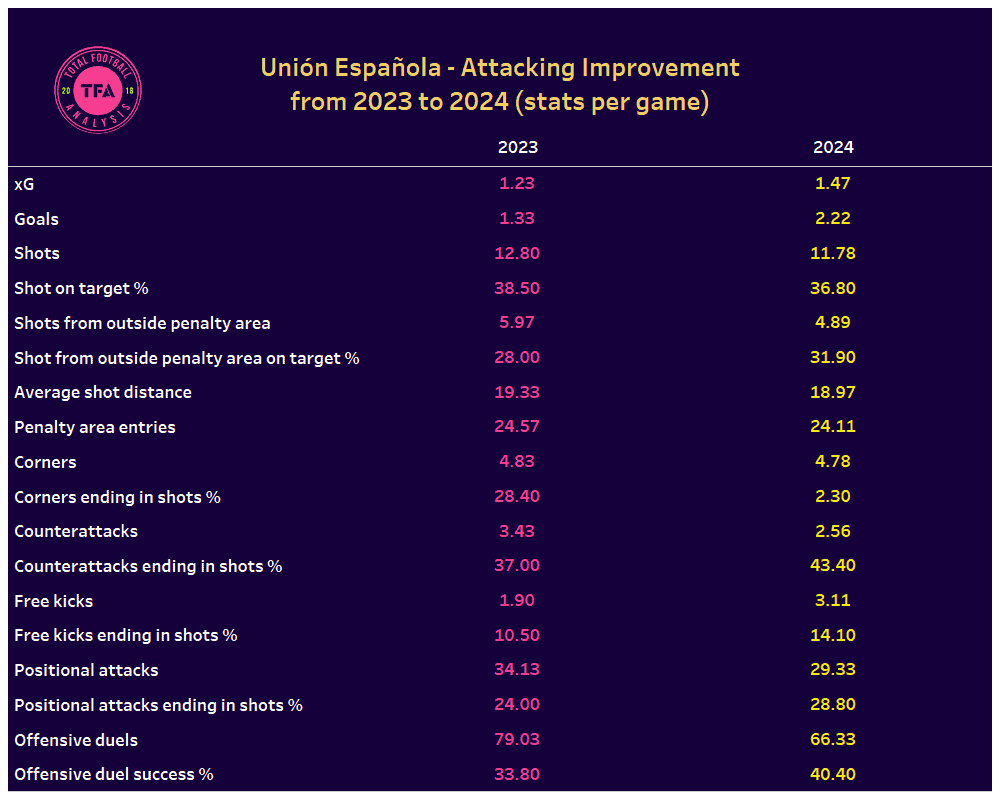
As the map below also shows, their reduced shooting volume has seen them prioritise better areas to shoot from, focusing on central areas ahead of the penalty spot compared to last season. Their xG per shot has improved as a result.
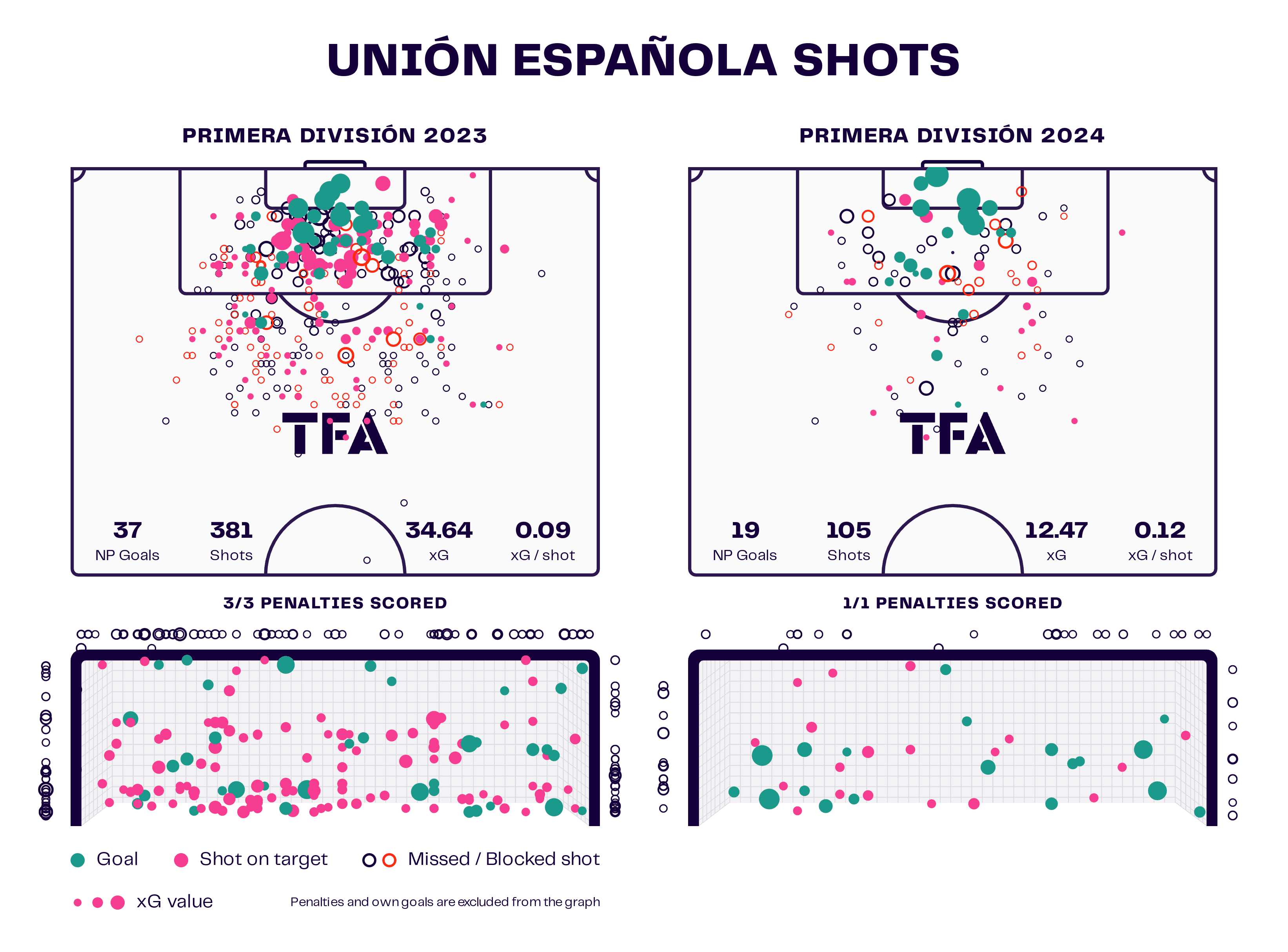
A better explanation for Unión’s improved offence under Ponce comes from their passing and creativity metrics.
The stats below suggest that they are averaging lower possession and passes per game. However, their forward passing accuracy has remained similar, while their lateral passing has improved. Perhaps most interestingly, they have become much better at completing both long passes (resulting in more deep completed passes) and crosses, revitalising their attack.
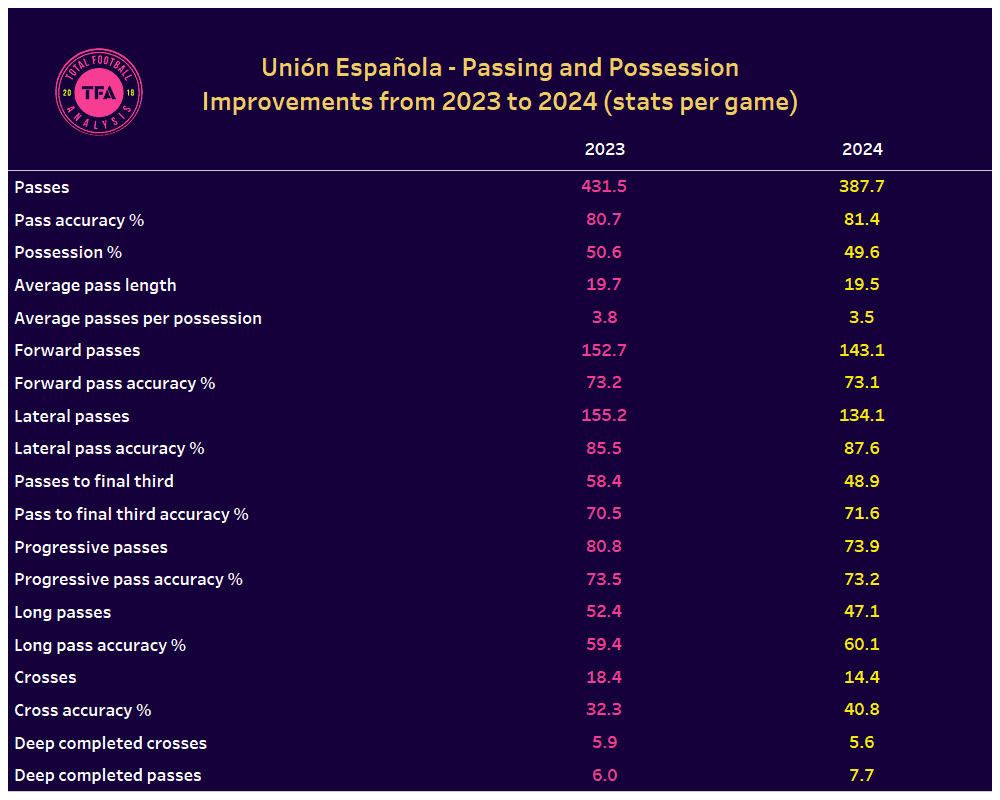
Formations and Personnel
Ponce has been relatively fluid with his formations this term. With a back-four as the foundation, he has deployed a 4-1-4-1, 4-2-3-1 and 4-3-3 at various points of the season.
In goal, 33-year-old Franco Torgnascioli has started all nine matches, with Jonathan Villagra and Bastián Roco consistently occupying the centre-back positions. Simón Ramírez has been a constant at right-back, while the left-back spot has been a toss-up between Nicolás Peñailillo, Luis Pavez Muñoz and most recently Stefano Magnasco.
Diego González has consistently started in holding midfield across formations, with Ignacio Núñez, who has featured in defensive and central midfield this season, for company. The third midfield spot has typically been taken up by Emiliano Vecchio, while right-winger Ariel Uribe has operated as the 10 in select formations as well.
However, Uribe has more prominently featured on the right wing, where he has excelled this term. On the other flank, Pablo Aránguiz has started all nine league matches. The centre-forward position, quite like the left-back situation, has been a toss-up. Ponce has tried Franco Frías there in more recent outings, but 21-year-old Valentín Adamo has received minutes upfront as well.
Left-winger Bastián Yáñez has been Ponce’s most-used substitute, coming off the bench in six of their nine matches. He is followed by midfielder Bruno Jáuregui (five substitute appearances) and wingers Fernando Ovelar and Gabriel Norambuena (both four).
Short Build-up Patterns
Unión’s build-up patterns throw up some interesting insights. They don’t follow the common trend of the defence fanning out to become a three with one of the full-backs moving higher up, but instead have all four defenders in the same line when the centre-backs move forward with the ball.
The full-backs still have a crucial role to play as a midfielder often drops back to help move the ball, with the defender either overlapping when the ball is out wide or tracking inside to occupy the space left by the midfielder. The midfielders’ off-the-ball movement is also vital as it enables the backline to play line-breaking passes and open up space to operate. Their wingers typically stay high and wide to ensure there are spaces between defenders for late runs from midfield and to send in crosses.
Consider the sequence below from their thrilling 5-3 win over Deportes Copiapó, where we see the first example. We see the entire defence staying in their own half while the holding midfielder drops back. As the ball is played out to the left, the midfielder gets into space between two players, while another off-the-ball run allows him to find a teammate in space to drive forward and spread the play to the right wing.
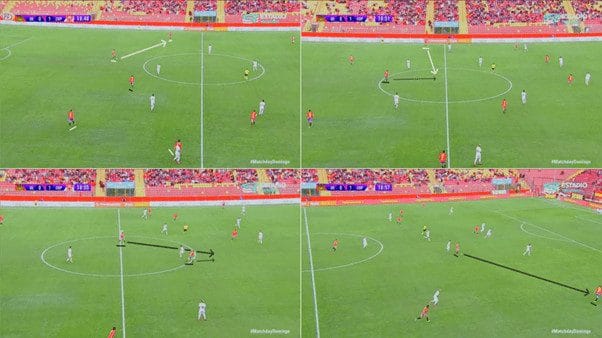
We see the advantage of having all four defenders assist in build-up against a high-pressing side in this clip below from their match against CD Everton. After a quick pass into midfield and an excellent turn, the left-back (marked in white) runs into midfield, drawing the attention of a defender to give the left-winger more room to operate.
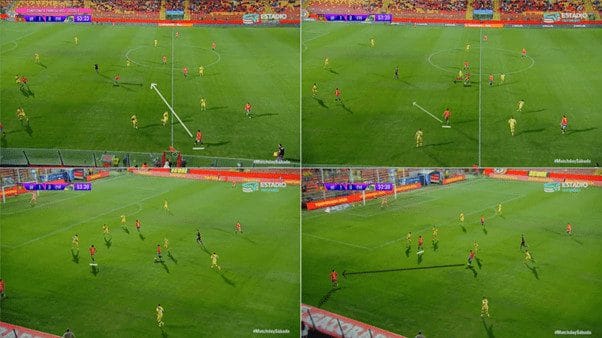
We get another glimpse of the full-back moving into midfield to provide an extra outlet in this sequence from the same game, though this time, the centre-back goes for a long ball which is intercepted.
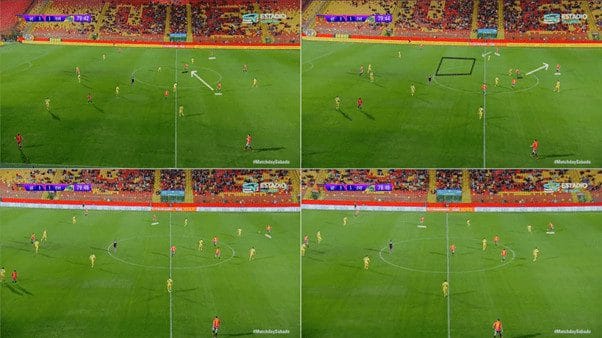
What makes Unión difficult to defend against is the fact that their full-backs can track into midfield and overlap as well, which causes confusion among the opposition. This will become more evident in the next section.
Goals and Goalscorers
As referenced earlier, Unión’s key attacking outlet has been long balls, while their crossing has been a massive plus point within their game. The map below shows just how effective they’ve been from crossing situations, particularly from the right, where Uribe has racked up four assists in nine league matches.
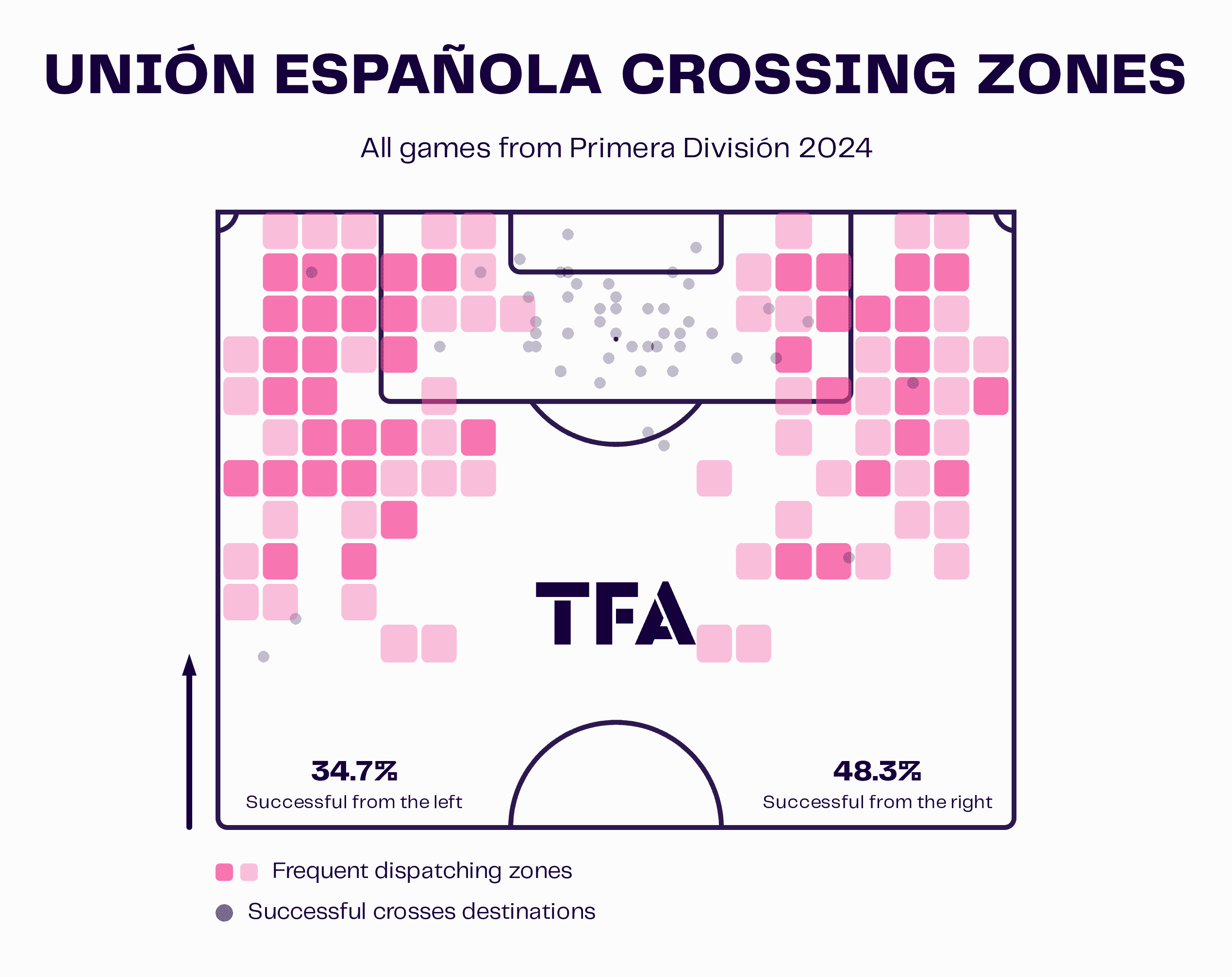
What makes this Unión season under Ponce special has also been the manner in which they have split the goalscoring burden. Five different players – Aránguiz, González, Frías, Vecchio and Ovelar – have netted thrice apiece, contributing to 15 of their 20 goals. The remaining five have been scored by Uribe, Villagra, Adamo, Magnasco and Yáñez. Uribe also leads the team in assists with four.
González’s goal against Ñublense is a perfect summation of Unión’s attacking fortunes. Here, the ball is played to Uribe on the right, and he then finds space to float a cross in, and it is met by González (marked in black), who makes the aforementioned late run into the box to nod the ball home.
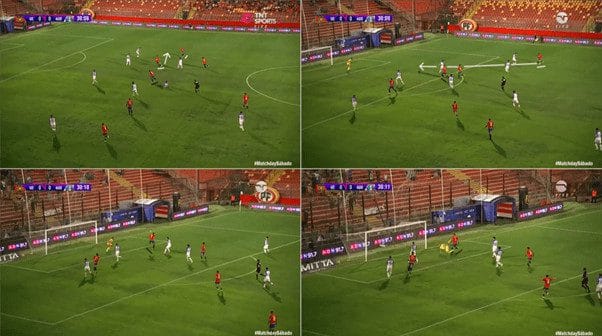
Vecchio has also done this exceptionally well on a few occasions this season, such as this goal against Coquimbo Unido. After a set piece is cleared, the ball is worked to the left wing and sent in towards the box, where Vecchio meets it after making a run in behind his marker and into the box, ending up as the furthest man forward to score.
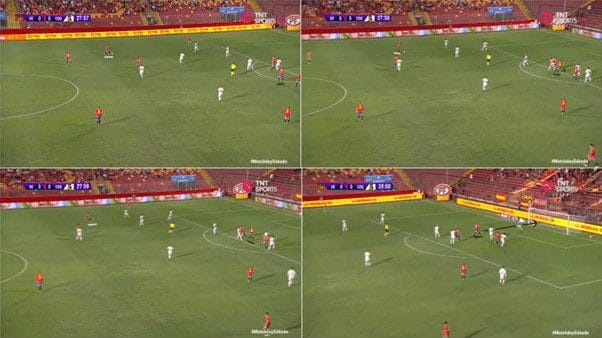
However, it’s not just balls over the top that Unión scores from. In the sequence below, Frías easily finds space between defenders in the box to tap home Aránguiz’s grounded ball across the box from a counter-attack, another area in which they excel.
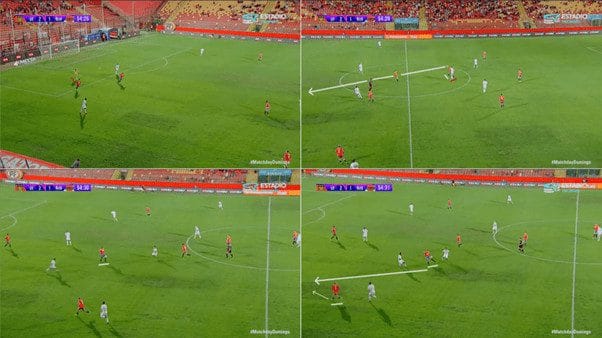
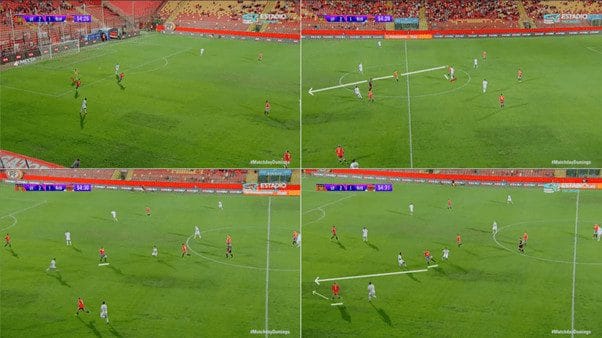
Similarly, one of Aránguiz’s goals this term also came from a counter-attack situation after Ponce’s men won the ball high up the pitch off of a loose pass. Here, they quickly switch the play from the right to the centre, where Uribe has surprisingly made a run infield, and he moves it to the left, where Aránguiz cuts in and shoots beyond the goalkeeper into the far corner.

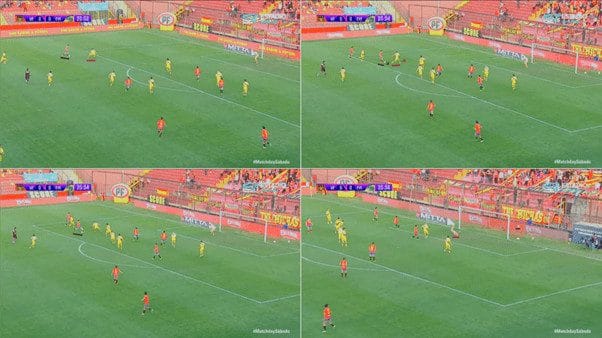
Uribe’s wand of a left foot also allows him to assist with inswingers from the left, as he does in this sequence below, where the role of the overlap becomes more evident. The left-back’s run behind Uribe leaves the defender confused and signalling to a teammate (in the top-right tile) to close the forward down. Unfortunately, the help comes late, and Uribe has enough time and space to measure a good cross into the box. The finish by Yáñez, who isn’t even facing the goal on the volley, is excellent as well.
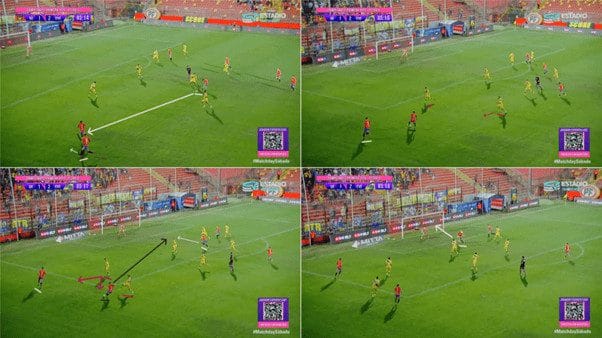
Conclusion
Unión Española have been one of the most exciting teams in South America in 2024. Their ability to create opportunities in a multitude of ways, including short build-up, long passes and crosses, has made them unpredictable and helped them trouble oppositions. Just nine matches in, they look like a title challenger and are on course for a top-two or top-three finish at the least.
However, there are areas to work on with the lack of threat from corners, which is both a surprise and a concern. They will also want to be braver when in possession as they have often resorted to lateral rather than forward passes.
Regardless, Miguel Ponce has worked wonders with this team which struggled for almost the entirety of last season and for much of the last 12 years. His impact on Unión has been tremendously positive, and the path ahead looks extremely promising.





Comments